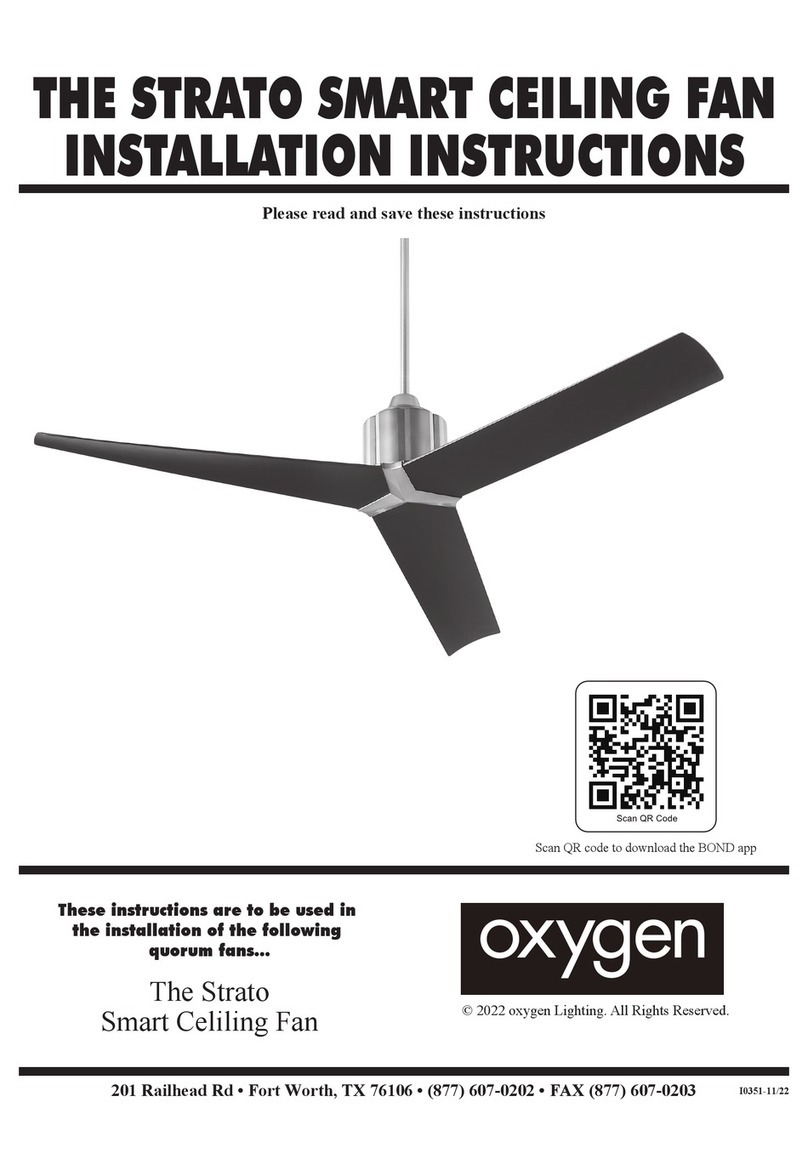
This warranty gives you specific legal
rights, and you may also have other rights
which vary from state to state.
WHAT IS COVERED-
Except as specified below, the manufacturer
of this product warrants it to be free of all
defects in workmanship and material.
WHAT IS NOT COVERED BY THIS
WARRANTY-
1. All costs of removal or reinstallation
of the fan.
2. Damage resulting from failure to
follow instructions contained herein.
3. Damage occurring during shipment of
the product (claims must be presented to
the carrier).
4. Damage resulting from accident,
misuse, abuse, or neglect.
5. Damage resulting from the application
of any exterior coating, or by the addition
of any unapproved accessories.
6. Damage resulting from repair or
attempted repair by anyone other than the
manufacturer.
7. Damage resulting from causes other
than product defects, including lack of
1. Most problems can be handled by our
customer service agents over the
telephone. Customers seeking warranty
repair or replacement for any fan or
component are encouraged to call us for
assistance. All returns must be issued a
Return Goods Authorization number
(RGA) prior to returning the defective
unit or part. Call (877) 607-0202 -
Monday thru Friday 8:00 a.m. - 5:00 p.m.
CST to obtain a RGA number.
2. Arriving shipments will be refused if
they do not bear a valid RGA number on
the outside packaging.
3. A dated proof of purchase must
accompany any fan or component clearly
indicating the name of the original
purchaser.
4. To avoid damage in transit, the
product should be returned in its original
box and packaging. Oxygen will not bear
responsibility for any shipping damage.
5. Any return of a fan or component
must be shipped freight and insurance
prepaid.
Complete and mail the enclosed
warranty card within 10 days to ensure
your warranty is registered.
If you have any questions regarding the
warranty, or the procedures for
obtaining service, please call us at
(877) 607-0202 - Monday thru Friday
8:00 a.m. - 5:00 p.m. CST.
technical skill, competence, or experience
of the user.
8. Light bulbs, glass or acrylic
components or accessories.
9. Minor occurrences of wobble are
accepted as normal and should not
necessarily be considered a defect.
WHO MAY ENFORCE WARRANTY-
This warranty may be enforced only by
the original purchaser. The end user must
possess a dated proof of purchase from an
authorized Oxygen dealer to establish a
warranty claim.
LENGTH OF THE WARRANTY -
1. For the fan motor - for the lifetime of
the original purchaser.
2. For everything else, except blades and
finish - one year from the date of
purchase.
3. For fan blades and finish - 90 days
from the date of purchase.
WHAT WE WILL PAY FOR -
We agree to correct defects outlined in the
warranty without charge, or at our option
replace the fan with an equivalent or
superior product if the defective unit is
returned prepaid to us.
TO GET WARRANTY SERVICE -
To obtain warranty service, the product
must be returned prepaid to Oxygen.
(This warranty is not enforceable outside
the United States.) Details regarding
return shipment are explained elsewhere
in this manual. Whenever warranty
service is required, you must present a
copy of the original dated sales receipt as
proof of coverage.
There is no other express warranty.
Oxygen hereby disclaims any and all
implied warranties, including but not
limited to those of merchantability of
fitness for a particular purpose to the
extent permitted by law. Oxygen shall not
be liable for incidental, consequential, or
special damages arising out of or in
connection with the product use or
performance except as may otherwise be
accorded by law. The duration of any
implied warranty which cannot be
disclaimed is limited to the periods
specified above in the express warranty.
OXYGEN'S UNIQUE LIMITED
LIFETIME WARRANTY
WARRANTY SERVICE
FOR YOUR RECORDS
Purchased From
City State
Fan Model No.
Date Purchased




























